A comic strip is a sequence of cartoons, arranged in interrelated panels to display brief humor or form a narrative, often serialized, with text in balloons and captions. Traditionally, throughout the 20th and into the 21st century, these have been published in newspapers and magazines, with daily horizontal strips printed in black-and-white in newspapers, while Sunday papers offered longer sequences in special color comics sections. With the advent of the internet, online comic strips began to appear as webcomics.
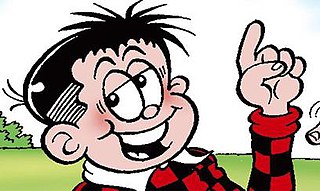
Roger the Dodger is a comic strip character from the comic magazine The Beano. He first appeared in his eponymous comic strip in 1953, and is one of the longest-running characters, characterised by his tactics for avoiding responsibility and his parents rules, or simply making chores easier, usually with the help of instructional "dodge" books.

The Phantom is an American adventure comic strip, first published by Lee Falk in February 1936. The main character, the Phantom, is a fictional costumed crime-fighter who operates from the fictional African country of Bangalla. The character has been adapted for television, film and video games.

Gnasher is a fictional comic strip character that appears in the British comic magazine The Beano. He is the pet dog of Dennis the Menace, who meets him in 1968's issue 1362, and is also the star of three spin-off comic strips. Gnasher is considered just as iconic as his owner as both have been the stars of many children's television programming and are the unofficial mascots of The Beano. Gnasher reached nationwide news in the 1980s after he disappeared from the magazine for seven weeks, returning with his six newborn puppies, but usually interacts with his son Gnipper.

Nutty was a British comic magazine that ran for 292 issues from 16 February 1980 to 14 September 1985, when it merged with The Dandy. Published by D. C. Thomson & Co. Ltd, Nutty was an attempt to create a more lively and chaotic comic compared to many on sale at the time.
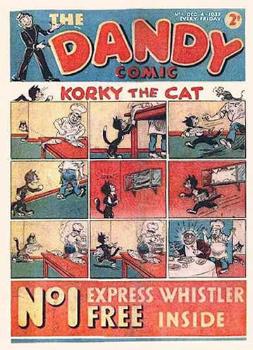
The Dandy was a Scottish children's comic magazine published by the Dundee based publisher DC Thomson. The first issue was printed in December 1937, making it the world's third-longest running comic, after Il Giornalino and Detective Comics. From August 2007 until October 2010, it was rebranded as Dandy Xtreme.

Steven Appleby, , is an absurdist cartoonist, illustrator and artist living in Britain. She is a dual citizen of the UK and Canada. Her humour has been described as “observational or absurd, with a keen sense of the turmoil of fear and obsession that teems beneath the respectable exterior of most of us.”
A daily strip is a newspaper comic strip format, appearing on weekdays, Monday through Saturday, as contrasted with a Sunday strip, which typically only appears on Sundays. They typically are smaller, 3–4 grids compared to the full page Sunday strip and are black and white.
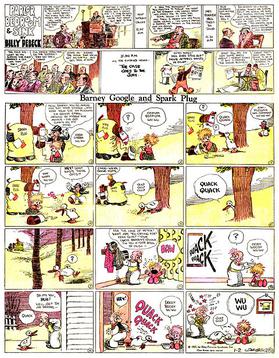
The Sunday comics or Sunday strip is the comic strip section carried in most western newspapers. Compared to weekday comics, Sunday comics tend to be full pages and are in color. Many newspaper readers called this section the Sunday funnies, the funny papers or simply the funnies.
Barry Appleby was a British cartoonist famous for creating The Gambols for the Daily Express. The strip premiered on 16 March 1950. The script was written by his wife Dobs, and was based on their own lives.

Krazy Kat is an American newspaper comic strip, created by cartoonist George Herriman, which ran from 1913 to 1944. It first appeared in the New York Evening Journal, whose owner, William Randolph Hearst, was a major booster for the strip throughout its run. The characters had been introduced previously in a side strip with Herriman's earlier creation, The Dingbat Family. Actually, Bill Blackbeard discovered two earlier appearances in the Herriman comic strip Baron Bean but almost all sources ignore this slightly earlier appearance. The phrase "Krazy Kat" originated there, said by the mouse by way of describing the cat. Set in a dreamlike portrayal of Herriman's vacation home of Coconino County, Arizona, KrazyKat's mixture of offbeat surrealism, innocent playfulness and poetic, idiosyncratic language has made it a favorite of comics aficionados and art critics for more than 80 years.

The Adventures of Smilin' Jack is an aviation comic strip that first appeared October 1, 1933, in the Chicago Tribune and ended April 1, 1973.
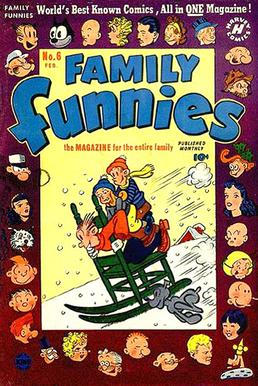
Toots and Casper is a family comic strip by Jimmy Murphy, distributed to newspapers for 37 years by King Features Syndicate, from December 17, 1918 to December 30, 1956. The strip spawned many merchandising tie-ins, including books, dolls, paper dolls, pins, bisque nodders and comic books.
Comic strip formats vary widely from publication to publication, so that the same newspaper comic strip may appear in a half-dozen different formats with different numbers of panels, different sizes of panels and different arrangement of panels.
Nigel Parkinson is a British cartoonist who works for D. C. Thomson & Co. Ltd and mainly draws for The Beano and The Dandy.
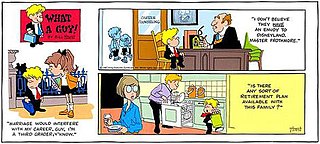
What a Guy! is an American comic strip created by Bill Hoest and Bunny Hoest, the team responsible for The Lockhorns and Agatha Crumm. It began in March 1987, just over a year before Hoest's death in 1988.
Barrie Appleby is a British comics artist who works mainly for Scottish publisher D. C. Thomson & Co., drawing strips such as Dennis the Menace and Roger the Dodger for The Beano since the 1970s. He has also drawn Cuddles and Dimples for The Dandy, as well as strips for Nutty, Hoot, Monster Fun and Buster. He also drew Bananaman in the BEEB comic. In 1999, he took over Bananaman in the Dandy from John Geering. He returned for a short time to do Bananaman in 2008.
Comics has developed specialized terminology. Several attempts have been made to formalize and define the terminology of comics by authors such as Will Eisner, Scott McCloud, R. C. Harvey and Dylan Horrocks. Much of the terminology in English is under dispute, so this page will list and describe the most common terms used in comics.
The New York World was one of the first newspapers to publish comic strips, starting around 1890, and contributed greatly to the development of the American comic strip. Notable strips that originated with the World included Richard F. Outcault's Hogan's Alley, Rudolph Dirks' The Captain and the Kids, Denys Wortman's Everyday Movies, Fritzi Ritz, Gus Mager's Hawkshaw the Detective, Victor Forsythe's Joe Jinks, and Robert Moore Brinkerhoff's Little Mary Mixup.










